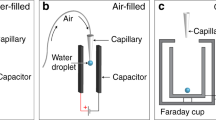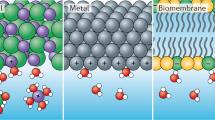Long-range hydrophobic interactions operating underwater are important in the mediation of many natural and synthetic phenomena.
Abstract
Long-range hydrophobic interactions operating underwater are important in the mediation of many natural and synthetic phenomena, such as protein folding, adhesion and colloid stability. Here we show that rough hydrophobic surfaces can experience attractive forces over distances more than 30 times greater than any reported previously, owing to the spontaneous evaporation of the intervening, confined water. Our finding highlights the importance of surface roughness in the interaction of extended structures in water, which has so far been largely overlooked.
Similar content being viewed by others
Main
The existence of 'long-range' hydrophobic interactions has been debated for more than 25 years1,2,3,4,5, because their reported range of 1–100 nanometres exceeds that of van der Waals forces and cannot be explained by water restructuring. However, investigations have been limited to smooth, flat model surfaces4, even though most surfaces are rough. Roughness strongly influences wetting — as evidenced by the high water-contact angles (θ≥160°) and rolling of water droplets on lotus leaves6.
Knowing that superhydrophobic surfaces occur naturally and that living systems operate mainly in water, we investigated the interaction of rough superhydrophobic surfaces beneath the water surface. Interfacial-force microscopy7 and optical imaging were used to examine the interaction between two approaching or retracting superhydrophobic surfaces (water contact angle θ of about 170°; see supplementary information) submerged in either air-equilibrated or de-aerated water.
We discovered a very-long-range hydrophobic interaction that was due to out-of-contact evaporation, or 'cavitation', of the intervening water at tip-to-substrate separations ranging from 0.8 µm to as much as 3.5 µm. Cavitation is a first-order phase transition characterized by a sudden, strong attractive force (Fig. 1a) and by the appearance of a vapour bridge spanning the tip-to-substrate gap (Fig. 1 b–e, and see supplementary information for details).
a, Plot of force versus displacement for the underwater approach of a tip towards a flat surface. The experiment starts at zero micrometres relative displacement (arbitrarily defined). The sudden development of a negative (attractive) force at about 0.4 µm relative displacement corresponds to cavitation. Contact with the surface is indicated by the inflection at about 2.2 µm (arrow). The distance between the onset of adhesion and contact (1.8 µm) is the distance over which cavitation occurs for this sample. The inset shows the cavitation geometry: Δp=γ(1/rw−1/rm), where Δp is the pressure difference across the interface, γ is the liquid–vapour interfacial tension, rm is the radius of the meniscus, rw is the radius of its waist, and rc is the contact radius of the cavity on the tip surface. D is the critical separation below which cavitation is thermodynamically favoured. See also supplementary information. b–e, Optical images of cavitation: b, position of superhydrophobic tip and substrate just before cavitation; c, cavitation occurs about 33 ms later; d, cavity meniscus, as seen during tip retraction, one frame before its unstable collapse; e, a cavity 'bubble' is left behind on both the tip and substrate. These bubbles, attributed to air supplied from water and the porous superhydrophobic surface, are unstable and are readsorbed in about 6 seconds. In all frames, the circular image at the bottom is the reflection of the spherical 150-µm-diameter tip in the flat superhydrophobic surface.
Pre-existing 'nanobubbles' of a size commensurate with the interaction length have been proposed as a source of long-range interactions8. We therefore used in situ confocal imaging to search for bubbles on an isolated, flat superhydrophobic surface (for details, see supplementary information). Neither the microscopy nor neutron reflectivity experiments9 provide evidence for bubbles — certainly not micrometre-sized bubbles. We therefore argue that cavitation is a consequence of, and thermodynamically consistent with, the properties of confined water10. The critical separation, D, below which cavitation is thermodynamically favoured can be estimated from Laplace's equation as 1.4 µm (see supplementary information): this is a lower bound and will increase if Δp, the pressure difference across the interface, is reduced by incorporation of air into the cavity.
Unambiguous cavitation has previously been observed only following the contact of smooth hydrophobic surfaces3,8,11. Although it is thermodynamically acceptable, out-of-contact cavitation has been modelled as having a large activation barrier12, so we need to explain why we observe it and how kinetic barriers are surmounted.
First, we used interfacial-force microscopy7, in which interfacial forces are counterbalanced, to avoid snap-to-contact (when the rate of change of the force exceeds the spring constant and the two surfaces snap together uncontrollably, as occurs in atomic-force microscopy and in surface-force apparatus studies5). Second, the calculated D for submerged superhydrophobic surfaces is more than ten times that of smooth surfaces, which increases the probability of cavity nucleation at larger separations. Third, the submerged superhydrophobic surface presents an intrinsic liquid/vapour/solid interface, which may serve as a heterogeneous nucleation surface.
We simulated the molecular dynamics of a model fluid, which showed the necessary liquid–vapour behaviour, confined between two closely spaced surfaces containing opposing (θ=180°) superhydrophobic patches. The simulations show that cavitation occurs by the growth of capillary-like fluctuations of vapour films extending from the superhydrophobic surfaces, leading to the sudden formation and growth of a vapour bridge.
Our experiments reveal that cavitation can be one source of long-range hydrophobic interactions. For rough surfaces, the interaction length extends to micrometre scales. Correspondingly, interaction lengths of hundreds of nanometres, observed for smooth surfaces (for example, snap-to-contact), might also be explained by cavitation, in agreement with thermodynamic expectations.
References
Blake, T. D. & Kitchener J. A. J. Chem. Soc. Farad. Trans. 1 68, 1435–1442 (1972).
Christenson, H. K. & Claesson, P. M. Adv. Colloid Interface Sci. 91, 391–436 (2001).
Christenson, H. K. & Claesson, P. M. Science 239, 390–392 (1988).
Israelachvili, J. & Pashley, R. Nature 300, 341–342 (1982).
Stevens, H., Considine, R. F., Drummond, C. J., Hayes, R. A. & Attard, P. Langmuir 21, 6399–6405 (2005).
Lafuma, A. & Quéré, D. Nature Mater. 2, 457–460 (2003).
Joyce, S. A. & Houston, J. E. Rev. Sci. Instr. 62, 710–715 (1991).
Parker, J. L., Claesson, P. M. & Attard, P. J. Phys. Chem. 98, 8468–8480 (1994).
Doshi, D. et al. Langmuir 21, 7805–7811 (2005).
Lum, K., Chandler, D. & Weeks, J. D. J. Phys. Chem. B 103, 4570–4577 (1999).
Pashley, R. M., McGuiggan, P. M., Ninham, B.W. & Evans, F. D. Science 229, 1088–1089 (1985).
Luzar, A. J. Phys. Chem. B 108 19859–19866 (2004).
Author information
Authors and Affiliations
Corresponding author
Ethics declarations
Competing interests
The authors declare no competing financial interests.
Supplementary information
Movie 1
This shows a series of confocal optical sections (Z-stack) through the fluorescently labelled superhydrophobic–water interface. The superhydrophobic film was labelled with the water-insoluble green fluorescent dye fluorescein, and submerged in water containing the water-soluble red fluorescent dye rhodamine B. Images were taken with a Zeiss LSM 510 using two simultaneous laser excitation sources (Ar (488 nm) and He-Ne (543)) and a 63X objective. Image scan size is 6.6 µm X6.6 µm X0.06 µm. (AVI 26881 kb)
Movie 2
This shows a similar Z stack. Image scan size is 29.2 µmX29.2 µm X0.06 µm. (AVI 15360 kb)
Rights and permissions
About this article
Cite this article
Singh, S., Houston, J., van Swol, F. et al. Drying transition of confined water. Nature 442, 526 (2006). https://doi.org/10.1038/442526a
Received:
Accepted:
Published:
Issue Date:
DOI: https://doi.org/10.1038/442526a
This article is cited by
-
Effects of liquid surface tension on gas capillaries and capillary forces at superamphiphobic surfaces
Scientific Reports (2023)
-
Diversified Aggregated Patterns of Alumina Inclusions in High-Al Iron Melt
Metallurgical and Materials Transactions B (2020)
-
Elastic superhydrophobic and water glass-based silica aerogels and applications
Journal of Sol-Gel Science and Technology (2019)
-
Agglomeration of Solid Inclusions in Molten Steel
Metallurgical and Materials Transactions B (2019)
-
Ultra-thin enzymatic liquid membrane for CO2 separation and capture
Nature Communications (2018)
Comments
By submitting a comment you agree to abide by our Terms and Community Guidelines. If you find something abusive or that does not comply with our terms or guidelines please flag it as inappropriate.




